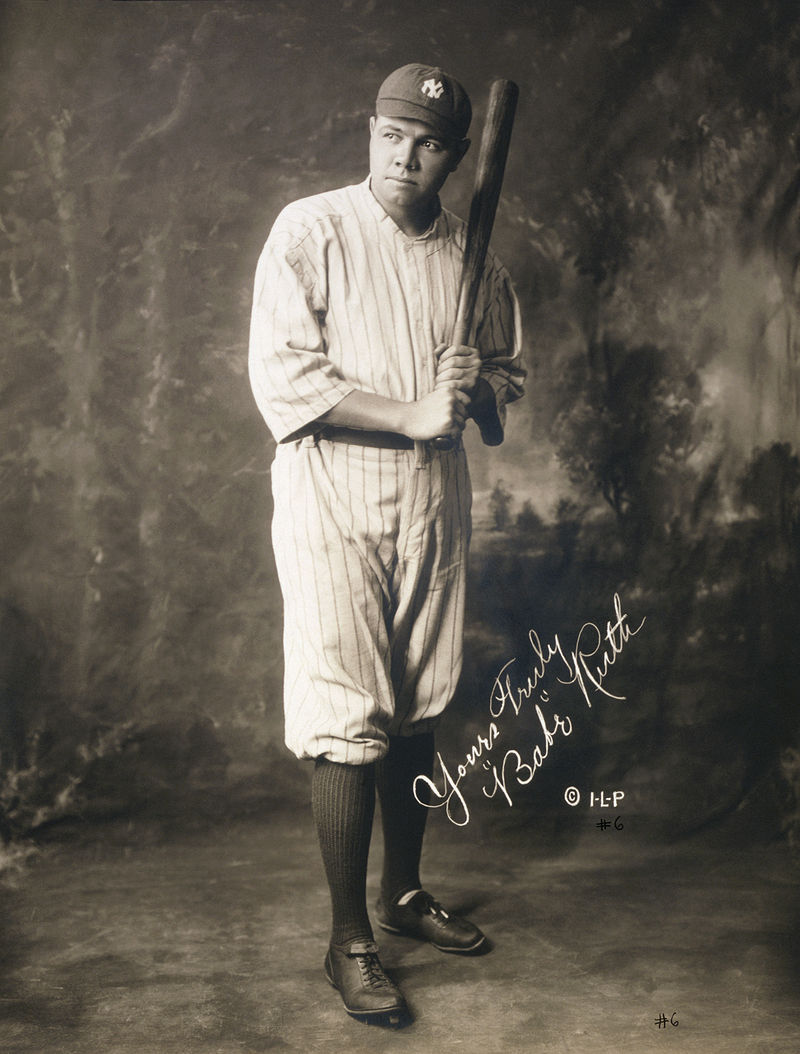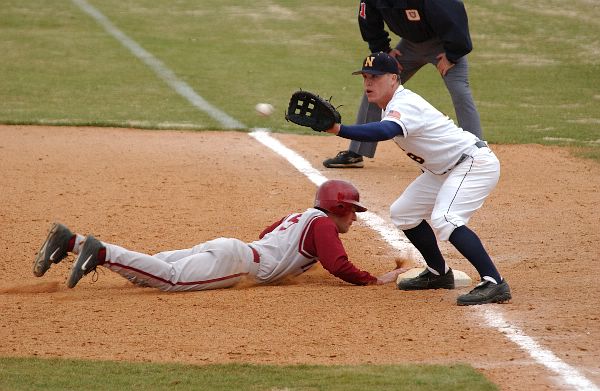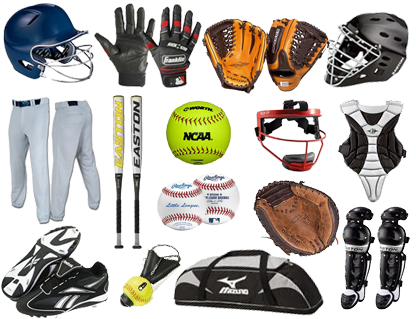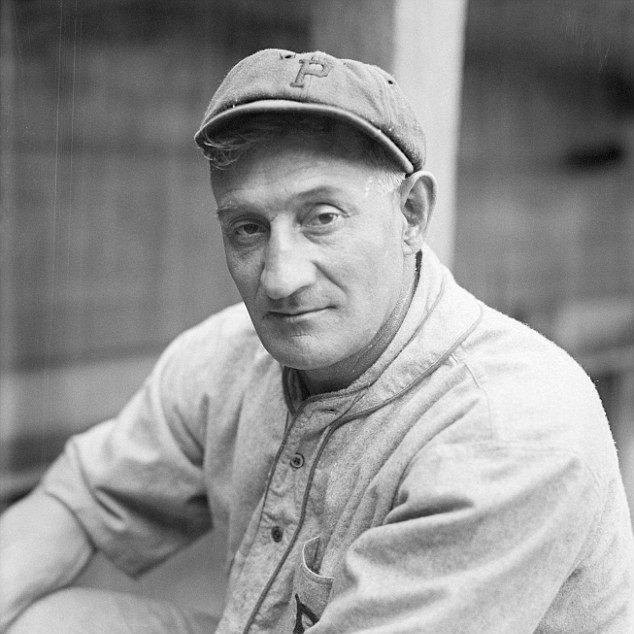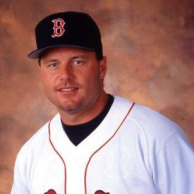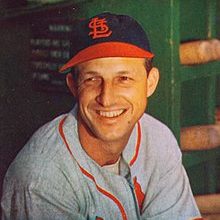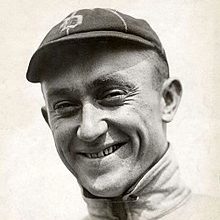A baseball game is played between two teams, each composed of nine players, that take turns playing offense (batting and baserunning) and defense (pitching and fielding). A pair of turns, one at bat and one in the field, by each team constitutes an inning. A game consists of nine innings (seven innings at the high school level and in doubleheaders in college and minor leagues, and six innings at the Little League level). One team—customarily the visiting team—bats in the top, or first half, of every inning. The other team—customarily the home team—bats in the bottom, or second half, of every inning. The goal of the game is to score more points (runs) than the other team. The players on the team at bat attempt to score runs by circling or completing a tour of the four bases set at the corners of the square-shaped baseball diamond. A player bats at home plate and must proceed counterclockwise to first base, second base, third base, and back home to score a run. The team in the field attempts to prevent runs from scoring and record outs, which remove opposing players from offensive action until their turn in their team’s batting order comes up again. When three outs are recorded, the teams switch roles for the next half-inning. If the score of the game is tied after nine innings, extra innings are played to resolve the contest. Many amateur games, particularly unorganized ones, involve different numbers of players and innings.
The game is played on a field whose primary boundaries, the foul lines, extend forward from home plate at 45-degree angles. The 90-degree area within the foul lines is referred to as fair territory; the 270-degree area outside them is foul territory. The part of the field enclosed by the bases and several yards beyond them is the infield; the area farther beyond the infield is the outfield. In the middle of the infield is a raised pitcher’s mound, with a rectangular rubber plate (the rubber) at its center. The outer boundary of the outfield is typically demarcated by a raised fence, which may be of any material and height. The fair territory between home plate and the outfield boundary is baseball’s field of play, though significant events can take place in foul territory, as well.
There are three basic tools of baseball: the ball, the bat, and the glove or mitt:
- The baseball is about the size of an adult’s fist, around 9 inches (23 centimeters) in circumference. It has a rubber or cork center, wound in yarn and covered in white cowhide, with red stitching.
- The bat is a hitting tool, traditionally made of a single, solid piece of wood. Other materials are now commonly used for nonprofessional games. It is a hard round stick, about 2.5 inches (6.4 centimeters) in diameter at the hitting end, tapering to a narrower handle and culminating in a knob. Bats used by adults are typically around 34 inches (86 centimeters) long, and not longer than 42 inches (106 centimeters).
- The glove or mitt is a fielding tool, made of padded leather with webbing between the fingers. As an aid in catching and holding onto the ball, it takes various shapes to meet the specific needs of different fielding positions.
Protective helmets are also standard equipment for all batters.
At the beginning of each half-inning, the nine players on the fielding team arrange themselves around the field. One of them, the pitcher, stands on the pitcher’s mound. The pitcher begins the pitching delivery with one foot on the rubber, pushing off it to gain velocity when throwing toward home plate. Another player, the catcher, squats on the far side of home plate, facing the pitcher. The rest of the team faces home plate, typically arranged as four infielders—who set up along or within a few yards outside the imaginary lines (basepaths) between first, second, and third base—and three outfielders. In the standard arrangement, there is a first baseman positioned several steps to the left of first base, a second baseman to the right of second base, a shortstop to the left of second base, and a third baseman to the right of third base. The basic outfield positions are left fielder, center fielder, and right fielder. With the exception of the catcher, all fielders are required to be in fair territory when the pitch is delivered. A neutral umpire sets up behind the catcher. Other umpires will be distributed around the field as well.
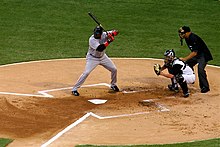
David Ortiz, the batter, awaiting a pitch, with the catcher and umpire
Play starts with a batter standing at home plate, holding a bat. The batter waits for the pitcher to throw a pitch (the ball) toward home plate and attempts to hit the ball with the bat. The catcher catches pitches that the batter does not hit—as a result of either electing not to swing or failing to connect—and returns them to the pitcher. A batter who hits the ball into the field of play must drop the bat and begin running toward first base, at which point the player is referred to as a runner (or, until the play is over, a batter-runner). A batter-runner who reaches first base without being put out is said to be safe and is on base. A batter-runner may choose to remain at first base or attempt to advance to second base or even beyond—however far the player believes can be reached safely. A player who reaches base despite proper play by the fielders has recorded a hit. A player who reaches first base safely on a hit is credited with a single. If a player makes it to second base safely as a direct result of a hit, it is a double; third base, a triple. If the ball is hit in the air within the foul lines over the entire outfield (and outfield fence, if there is one), or otherwise safely circles all the bases, it is a home run: the batter and any runners on base may all freely circle the bases, each scoring a run. This is the most desirable result for the batter. A player who reaches base due to a fielding mistake is not credited with a hit—instead, the responsible fielder is charged with an error.
Any runners already on base may attempt to advance on batted balls that land, or contact the ground, in fair territory, before or after the ball lands. A runner on first base must attempt to advance if a ball lands in play. If a ball hit into play rolls foul before passing through the infield, it becomes dead and any runners must return to the base they occupied when the play began. If the ball is hit in the air and caught before it lands, the batter has flown out and any runners on base may attempt to advance only if they tag up (contact the base they occupied when the play began, as or after the ball is caught). Runners may also attempt to advance to the next base while the pitcher is in the process of delivering the ball to home plate; a successful effort is a stolen base.
A pitch that is not hit into the field of play is called either a strike or a ball. A batter against whom three strikes are recorded strikes out. A batter against whom four balls are recorded is awarded a base on balls or walk, a free advance to first base. (A batter may also freely advance to first base if the batter’s body or uniform is struck by a pitch outside the strike zone, provided the batter does not swing and attempts to avoid being hit.) Crucial to determining balls and strikes is the umpire’s judgment as to whether a pitch has passed through the strike zone, a conceptual area above home plate extending from the midpoint between the batter’s shoulders and belt down to the hollow of the knee.
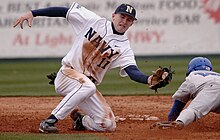
A shortstop tries to tag out a runner who is sliding headfirst, attempting to reach second base.
While the team at bat is trying to score runs, the team in the field is attempting to record outs. In addition to the strikeout, common ways a member of the batting team may be put out include the flyout, ground out, force out, and tag out. It is possible to record two outs in the course of the same play. This is called a double play. Three outs in one play, a triple play, is possible, though rare. Players put out or retired must leave the field, returning to their team’s dugout or bench. A runner may be stranded on base when a third out is recorded against another player on the team. Stranded runners do not benefit the team in its next turn at bat as every half-inning begins with the bases empty.
An individual player’s turn batting or plate appearance is complete when the player reaches base, hits a home run, makes an out, or hits a ball that results in the team’s third out, even if it is recorded against a teammate. On rare occasions, a batter may be at the plate when, without the batter’s hitting the ball, a third out is recorded against a teammate—for instance, a runner getting caught stealing (tagged out attempting to steal a base). A batter with this sort of incomplete plate appearance starts off the team’s next turn batting; any balls or strikes recorded against the batter the previous inning are erased. A runner may circle the bases only once per plate appearance and thus can score at most a single run per batting turn. Once a player has completed a plate appearance, that player may not bat again until the eight other members of the player’s team have all taken their turn at bat. The batting order is set before the game begins, and may not be altered except for substitutions. Once a player has been removed for a substitute, that player may not reenter the game. Children’s games often have more liberal substitution rules.
If the designated hitter (DH) rule is in effect, each team has a tenth player whose sole responsibility is to bat (and run). The DH takes the place of another player—almost invariably the pitcher—in the batting order, but does not field. Thus, even with the DH, each team still has a batting order of nine players and a fielding arrangement of nine players.

